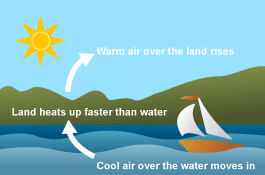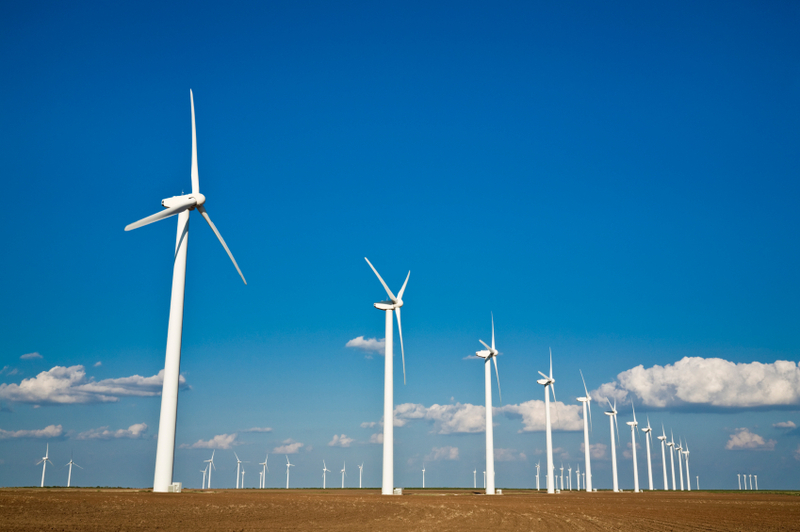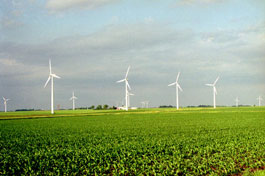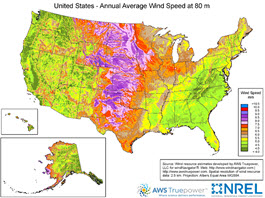Wind Basics
Energy from moving air
How uneven heating of water and land causes wind

Wind is caused by uneven heating of the earth's surface by the sun. Because the earth's surface is made up of different types of land and water, it absorbs the sun's heat at different rates. One example of this uneven heating is the daily wind cycle.
The daily wind cycle
During the day, air above the land heats up faster than air over water. Warm air over land expands and rises, and heavier, cooler air rushes in to take its place, creating wind. At night, the winds are reversed because air cools more rapidly over land than it does over water.
In the same way, the atmospheric winds that circle the earth are created because the land near the earth's equator is hotter than the land near the North Pole and the South Pole.
Wind energy for electricity generation
Today, wind energy is mainly used to generate electricity. Water-pumping windmills were once used throughout the United States and some still operate on farms and ranches, mainly to supply water for livestock.
Electricity Generation from Wind
Diagram of wind turbine components

How wind turbines work
Wind turbines use blades to collect the wind’s kinetic energy. Wind flows
over the blades creating lift (similar to the effect on airplane wings),
which causes the blades to turn. The blades are connected to a drive shaft that turns an
electric generator, which produces the electricity.
Electricity generation with wind
In 2017, wind turbines in the United States were the source of nearly 6.3% of total U.S. utility-scale electricity generation.
The amount of electricity generated from wind has grown significantly since 2000. Electricity generation from wind in the United States increased from about 6 billion kilowatthours (kWh) in 2000 to about 254 billion kWh in 2017.
New technologies have decreased the cost of producing electricity from wind, and growth in wind power has been encouraged by government and industry incentives.
Where Wind is Harnessed
Wind power plants require careful planning
Operating a wind power plant is more complex than simply erecting wind turbines in a windy area. Wind power plant owners must carefully plan where to position wind turbines and must consider how fast and how often the wind blows at the site.
Wind turbines in the ocean

Wind speed typically increases with altitude and increases over open areas without windbreaks. Good sites for wind turbines include the tops of smooth, rounded hills; open plains and water; and mountain gaps that funnel and intensify wind.
Wind speeds are not the same across the country
Wind speeds vary throughout the United States. Wind speeds also vary throughout the day and from season to season. In Tehachapi, California, where numerous wind turbines are located, the wind blows more frequently from April through October than it does in the winter. This fluctuation is a result of the extreme heat of the Mojave Desert during the summer months. As the hot air over the desert rises, the cooler, denser air above the Pacific Ocean rushes through the Tehachapi mountain pass to take its place. In a high altitude Great Plains state such as Montana, strong winter winds channeled through the Rocky Mountain valleys create more intense winds during the winter.
Fortunately, the seasonal variations in wind speeds in California and Montana match the electricity demands of consumers in those states. In California, people use more electricity during the summer for air conditioners. In Montana, people use more electricity, in general, during the winter.
Locations of U.S. wind power projects
In 2017, 40 states had utility-scale wind power projects. The five states with the most electricity generation from wind in 2017 were Texas, Oklahoma, Iowa, Kansas, and California. These states combined produced about 66% of total U.S. wind electricity generation in 2017.
International wind power
In 2015, about 834 billion kilowatthours were generated with wind energy in 116 countries. Most wind power projects are located in Europe and in the United States where government programs have supported wind power development. China and India have increased wind electricity generation in recent years and were among the top five producers of electricity generation from wind in 2015. The top five countries in wind electricity generation and their shares of world total wind electricity generation in 2015 were
- United States—23%
- China—22%
- German—9%
- Spain—6%
- India—5%
Offshore wind power
The waters off the coasts of the United States have significant potential for electricity generation from wind energy. The first U.S. offshore wind power project began operation off the coast of Rhode Island in 2016. Several other wind projects off the U.S. East Coast are in the planning stages. Europe has a number of operating offshore wind energy projects.
Types of Wind Turbines
Horizontal-axis wind turbines on a wind farm

Darrieus vertical-axis wind turbine in Martigny, Switzerland

There are two basic types of wind turbines:
- Horizontal-axis turbines
- Vertical-axis turbines
The size of wind turbines varies widely. The length of the blades is the biggest factor in determining the amount of electricity a wind turbine can generate. Small wind turbines that can power a single home may have an electricity generating capacity of 10 kilowatts (kW). The largest wind turbines in operation have electricity generating capacities of up to 10,000 kW, and larger turbines are in development. Large turbines are often grouped together to create wind power plants, or wind farms, that provide power to electricity grids.
Horizontal-axis turbines are similar to propeller airplane engines
Horizontal-axis turbines have blades like airplane propellers, and they commonly have three blades. The largest horizontal-axis turbines are as tall as 20-story buildings and have blades more than 100 feet long. Taller turbines with longer blades generate more electricity. Nearly all of the wind turbines currently in use are horizontal-axis turbines.
Vertical-axis turbines look like egg beaters
Vertical-axis turbines have blades that are attached to the top and the bottom of a vertical rotor. The most common type of vertical-axis turbine—the Darrieus wind turbine, named after the French engineer Georges Darrieus who patented the design in 1931—looks like a giant, two-bladed egg beater. Some versions of the vertical-axis turbine are 100 feet tall and 50 feet wide. Very few vertical-axis wind turbines are in use today because they do not perform as well as horizontal-axis turbines.
Wind power plants, or wind farms, produce electricity
Wind power plants, or wind farms, are clusters of wind turbines that produce large amounts of electricity. A wind farm usually has many turbines scattered over a large area. One of the world's largest wind farms, the Horse Hollow Wind Energy Center in Texas, has about 430 wind turbines spread over about 47,000 acres. The project has a combined electricity generating capacity of about 735 megawatts (or 735,000 kW).
History of Wind Power
People have been using wind energy for thousands of years
Traditional Dutch windmill

People used wind energy to propel boats along the Nile River as early as 5,000 BC. By 200 BC, simple wind-powered water pumps were used in China, and windmills with woven-reed blades were grinding grain in Persia and the Middle East.
New ways to use wind energy eventually spread around the world. By the 11th century, people in the Middle East were using windpumps and windmills extensively for food production. Merchants and the Crusaders brought wind technology to Europe. The Dutch developed large wind pumps to drain lakes and marshes in the Rhine River Delta. Immigrants from Europe eventually took wind energy technology to the Western Hemisphere.
American colonists used windmills to grind grain, to pump water, and to cut wood at sawmills. Homesteaders and ranchers installed thousands of wind pumps as they settled the western United States. In the late 1800s and early 1900s, small wind-electric generators (turbines) were also widely used.
When power lines were built to transmit electricity to rural areas in the 1930s, wind pump and small turbine use began to decline. However, some ranches still use wind pumps to supply water for livestock. Small wind turbines are becoming common again, mainly to supply electricity in remote and rural areas.
Wind energy use expanded in the wake of oil shortages and environmental concerns
Modern wind turbines

The oil shortages of the 1970s changed the energy environment for the United States and the world. The oil shortages created an interest in developing ways to use alternative energy sources, such as wind energy, to generate electricity. The U.S. federal government supported research and development of large wind turbines. In the early 1980s, thousands of wind turbines were installed in California, largely because of federal and state policies that encouraged the use of renewable energy sources.
In the 1990s and 2000s, the U.S. federal government established incentives to use renewable energy sources in response to a renewed concern for the environment. The federal government also provided research and development funding to help reduce the cost of wind turbines and offered tax and investment incentives for wind power projects. In addition, state governments enacted new requirements for electricity generation from renewable sources, and electric power marketers and utilities began to offer electricity generated from wind and other renewable energy sources (sometimes called green power) to their customers. These policies and programs resulted in an increase in the number of wind turbines and in the amount of electricity generated from wind energy.
The share of U.S. electricity generation from wind in 1990 was less than 1%. In 2017, the share of U.S. electricity generation from wind was about 6%. Incentives in Europe have resulted in a large expansion of wind energy use there. China is investing heavily in wind energy and now has the world's largest wind electricity generation capacity.
Wind Energy & the Environment
Wind is an emissions-free source of energy
Wind turbines at the Cerro Gordo Project, west of Mason City, Iowa

Wind is a renewable energy source. Overall, using wind to produce energy has fewer effects on the environment than many other energy sources. Wind turbines do not release emissions that can pollute the air or water (with rare exceptions), and they do not require water for cooling. Wind turbines may also reduce the amount of electricity generation from fossil fuels, which results in lower total air pollution and carbon dioxide emissions.
An individual wind turbine has a relatively small physical footprint. Groups of wind turbines, sometimes called wind farms, are located on open land, on mountain ridges, or offshore in lakes or the ocean.
Wind turbines have some negative effects on the environment
Modern wind turbines can be very large machines, and they may visually affect the landscape. A small number of wind turbines have also caught fire, and some have leaked lubricating fluids, but these occurrences are rare. Some people do not like the sound that wind turbine blades make as they turn in the wind. Some types of wind turbines and wind projects cause bird and bat deaths. These deaths may contribute to declines in the population of species also affected by other human-related impacts. The wind energy industry and the U.S. government are researching ways to reduce the effect of wind turbines on birds and bats.
Most wind power projects on land require service roads that add to the physical effects on the environment. Wind turbines may also use rare earth minerals. These minerals are often located in countries with less stringent environmental standards than the United States, and mining these minerals can have negative effects on the environment. Producing the metals and other materials used to make wind turbines and the concrete used for their foundations requires energy that may have been produced by fossil fuels.













